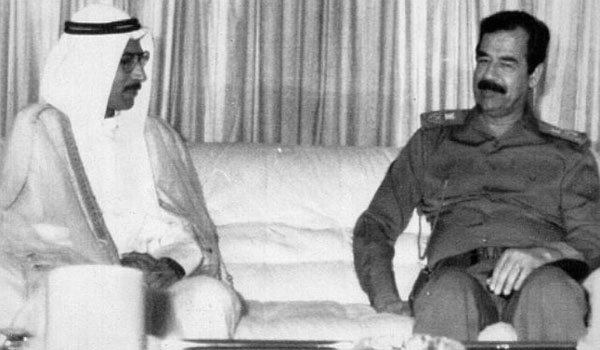
An Overview / By Mark Albertson: Major General Rudolph Ostovich III, offered some pointed observations concerning the world situation, as a result of the political collapse of the Soviet Union:
- The breaching of the Berlin Wall, signifying the ongoing reunification of Germany.
- The dissolution of the Warsaw Pact; which in essence was not a military alliance as much as it was an empire overseen by the Kremlin.
- The humbling of the Soviet monolith; a vindication of George Kennan’s post-World War II doctrinal approach to the Soviet challenge known as, Containment.(1)

Saddam Hussein meeting with Republic of Kuwait President Ala’a Hussein Ali Al-Khafaji Al-Jaber, 1990.
However the reality of the world is that whenever a despotic regime vacates the scene, another rears its ugly head to fill the void or wreck havoc. Reference here is to Saddam Hussein, who saw fit to steamroller Kuwait in August of 1990.(2) This necessitated a coalition of forces from the United Nations and NATO to serve the Iraqi strongman his eviction notice; an effort which included Army Aviation. As Major General Ostovich writes:
“Army Aviation’s role in this conflict are manifold. Apache attack helicopters are participating in both air and ground campaigns as partners with aircraft and ground maneuver forces of other services and nations. Helicopters of the 1-82 Aviation Battalion were immediately deployed as part of the 82nd Airborne Division’s Ready Brigade, the first U.S. ground forces on the scene, to bolster the anti-armor capability of this light force. The 82nd Airborne’s aviation assets were closely followed and augmented by those of the 101st, 24th, and USAREUR’s(3) 12th Aviation.”
Despite the ongoing transition in the global situation, the flexibility and deployability of the United States Army’s aviation branch makes it an essential tool in preserving the strategic interests of our Grand Republic in the post-Soviet world.
Notes

Noted Sovietologist and author of Containment, George Kennan.
1. In 1945, the inimitable George Kennan, noted Sovietologist, diplomat, writer, historian . . . , understood the reality of 1945: That the enduring primacy enjoyed by the imperialist powers of Europe was over. The war started by reactionary monarchs in 1914 had come to an end in 1945. A global struggle that produced two winners; a pair of industrial monoliths, outsiders from that archaic fraternity of Western European colonial powers; who with their triumph forever altered the strategic balance of power: They are of course, the United States and the Soviet Union.
Kennan understood, too, that the Soviets were not the threat to world peace, as then being trumpeted, in comparison to the more impetuous and recently defeated Third Reich. According to Kennan, America could outlast the Soviets in any strategic competition by virtue of its superior economy; its more palatable political alternative; intelligent use of propaganda; and, our employment—when necessary—of armed might in limited quantities within limited conflicts. In other words, Containment, a measured strategic response intended to outlast the Soviet challenge within that strategic arena known as the Cold War.
During the Korean War, as a staunch advocate of Containment, Kennan objected to MacArthur’s thrust across the 38th parallel following the successful landings at Inchon; seeing such a campaign as provoking Communist China into action and therefore, widening the conflict, which in the end, produced a costly contest of attrition reminiscent of the Western Front in World War I. He raised objections to the Kennedy White House concerning the risk of American time, treasure and prestige in the jungles of Southeast Asia. And when 99 years old, George Kennan warned George W. Bush of the impending calamities that were sure to be the result of American troops in that minefield of enduring grievances, religious differences and ethnic passions known as the Cradle of Civilization, AKA, Iraq.
However the collapse of the Soviet Empire without resorting to a ruinous global conflict has shown George Kennan to be, for the most part, correct.
2. Saddam’s war with Iran, 1979-1988, ran up a debt of upwards of $100 billion. Baghdad’s benefactors, such as Saudi Arabia and Kuwait, were among those who saw fit not to continue to assist Saddam with his financial woes. So the Iraqi dictator invaded Kuwait.
By absorbing his neighbor into Iraq (reclaiming Iraq’s lost 19th province, according to Baghdad), Saddam virtually doubled the size of his oil reserves; which he hoped would give him a larger voice in OPEC; therefore, translating into a greater ability to be able set the price of oil to Iraq’s advantage. Paying such tribute was an anathema to the Western Powers which were at one time his supporters. So Saddam had worn out his welcome and had to go, hence Desert Storm in 1991.

General Rudolph Ostovich III (Ret.) courtesy of, General Rudolph Ostovich III, (Ret.).
3. USAREUR, United States Army in Europe.
For those looking to read Major General Ostovich’s remarks in total, refer to “The Aviation Center: An Overview,” Army Aviation, Army Aviation Publications, Inc., Westport, Ct., March-April, 1991.










